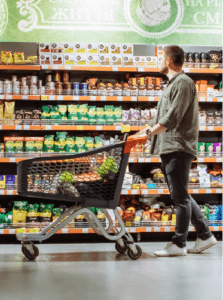Chapter 2:
Establishing Shopping Behavior
To truly understand shopper behavior, you need to distinguish these three main areas: stopping power, shopability, and activation.

Stopping power is the ability to attract the attention of your target shopper.

Shopability is how easily your target shopper can find your product, both in-store and online.

Activation (Closing Power) is the driving force that initiates your shopper to decide to purchase your product.
Stopping power encompasses three steps: attract, interrupt, and engage. In-store and online, this encompasses having the right packaging design. Shopability is all about making your product easy for the shopper to find. In-store, this requires you to know where on the shelf your product will be best optimized, while online, this is about how organized the products are. Activation will provide the correct information to inspire the shopper to decide to buy your product. Online this can be testimonials or informative product information, and in-store this can include the information on packaging, at-shelf, or other signage communication.
So now you know what Stopping Power, Shopability, and Activation are, but how do you establish this regarding your current products? You need to ask yourself the following questions.
You can ask yourself the following questions about Stopping Power, Shopability and Activation. If you can’t answer most of these questions you might want to consider developing a Shopper Insights plan to start building your knowledge base.
Stopping Power – Reach
Key Questions:
- Where are the target shoppers shopping; is it the aisle or online?
- How much exposure is my product receiving in-store or online?
- What opportunities exist based on in-store shopping trip types or online purchasing shopper needs?
- How can I increase the visibility and conversion rate for my products?

Shopability – Involvement & Ease
Key Questions:
- How easy is it for the shopper to find my product?
- Does the planogram or online page layout align with the shopper’s needs?
- Where is the ideal assortment and allocation?
- Does shopping behavior vary based on the shopping trip type or demographics?
Activation – Closing Power
Key Questions:
- How are shoppers shopping the brand, and how does my brand compare to competitors?
- What triggers the shopper to purchase?
- How can I retain and grow my ideal customers?
- What different shopper segments shop my brand?
If you can’t answer most of these questions, you should consider developing a Shopper Insights strategy to develop shopper-centric approaches.
